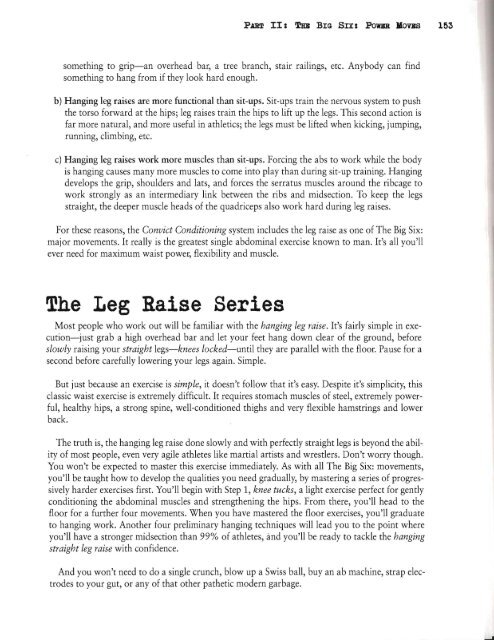Convict Conditioning - Paul Wade
Create successful ePaper yourself
Turn your PDF publications into a flip-book with our unique Google optimized e-Paper software.
P.mr II: TmI BIG SIX: PoUR )(OVRS 153<br />
something to grip-an overhead bar, a tree branch, stair railings, etc. Anybody can find<br />
something to hang from if they look hard enough.<br />
b) Hanging leg raises are more functional than sit-ups. Sit-ups train the nervous system to push<br />
the torso forward at the hips; leg raises train the hips to lift up the legs. This second action is<br />
far more natural, and more useful in athletics; the legs must be lifted when kicking, jumping,<br />
running, climbing, etc.<br />
c) Hanging leg raises work more muscles than sit-ups. Forcing the abs to work while the body<br />
is hanging causes many more muscles to come into play than during sit-up training. Hanging<br />
develops the grip, shoulders and lats, and forces the serratus muscles around the ribcage to<br />
work strongly as an intermediary link between the ribs and midsection. To keep the legs<br />
straight, the deeper muscle heads of the quadriceps also work hard during leg raises.<br />
For these reasons, the <strong>Convict</strong> <strong>Conditioning</strong> system includes the leg raise as one of The Big Six:<br />
major movements. It really is the greatest single abdominal exercise known to man . It's all you'll<br />
ever need for maximum waist power, flexibility and muscle.<br />
The Leg Raise Series<br />
Most people who work out will be familiar with the hanging leg raise. It's fairly simple in execution-just<br />
grab a high overhead bar and let your feet hang down clear of the ground, before<br />
slowly raising your straight legs-knees locked-until they are parallel with the floor. Pause for a<br />
second before carefully lowering your legs again. Simple.<br />
But just because an exercise is simple, it doesn't follow that it's easy. Despite it's simplicity, this<br />
classic waist exercise is extremely difficult. It requires stomach muscles of steel, extremely powerful,<br />
healthy hips, a strong spine, well-conditioned thighs and very flexible hamstrings and lower<br />
back.<br />
The truth is, the hanging leg raise done slowly and with perfectly straight legs is beyond the ability<br />
of most people, even very agile athletes like martial artists and wrestlers . Don't worry though.<br />
You won't be expected to master this exercise immediately. As with all The Big Six: movements,<br />
you'll be taught how to develop the qualities you need gradually, by mastering a series of progressively<br />
harder exercises first. You'll begin with Step 1, knee tucks, a light exercise perfect for gently<br />
conditioning the abdominal muscles and strengthening the hips. From there, you'll head to the<br />
floor for a further four movements. When you have mastered the floor exercises, you'll graduate<br />
to hanging work. Another four preliminary hanging techniques will lead you to the point where<br />
you'll have a stronger midsection than 99% of athletes, and you'll be ready to tackle the hanging<br />
straight leg raise with confidence.<br />
And you won't need to do a single crunch, blow up a Swiss ball, buy an ab machine, strap electrodes<br />
to your gut, or any of that other pathetic modern garbage.


